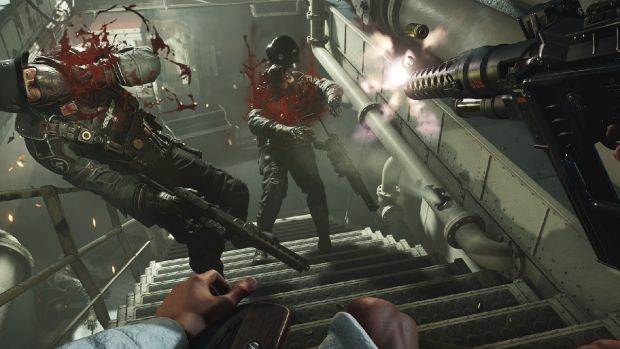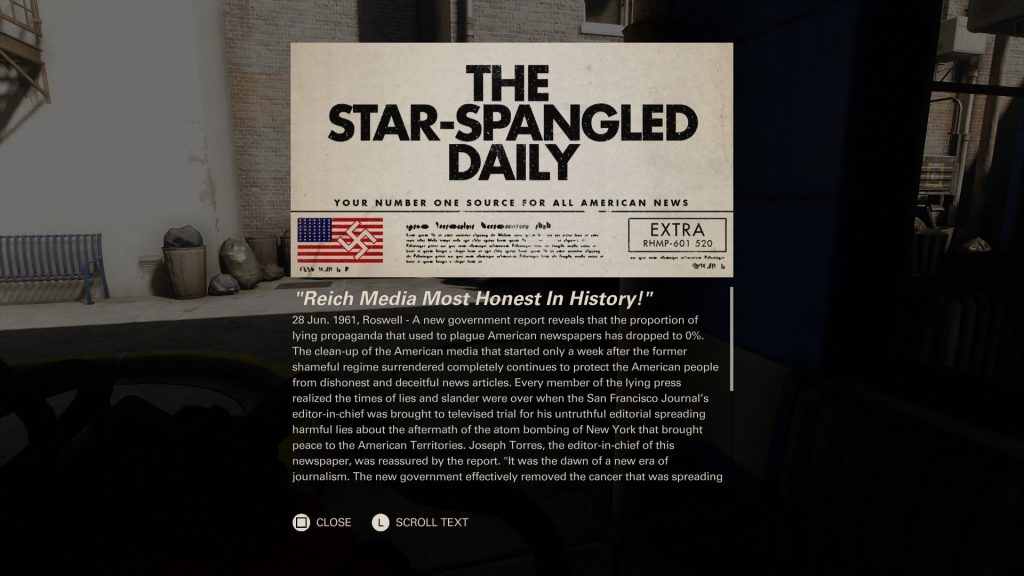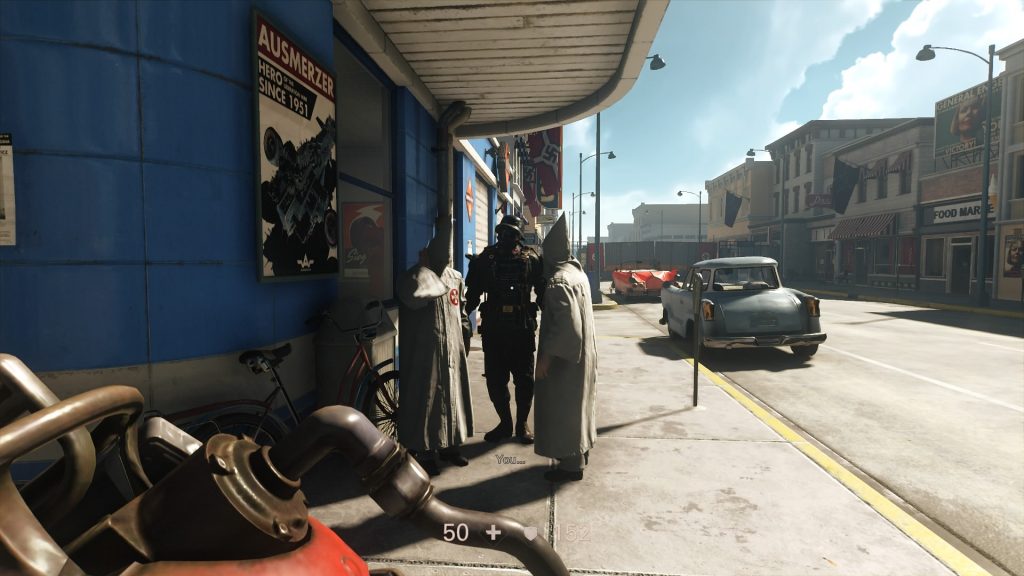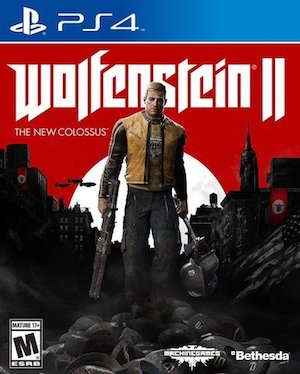
When Wolfenstein: The New Order released, I wrote that there were three things that video games would never make you able to feel bad about killing: monsters, zombies, and Nazis. In 2014, that was a fairly bland statement to make. Monsters were monsters, zombies were already dead, and Nazis were, well, Nazis. Let’s not beat around the bush: Nazis, actual, goose-stepping, Hitler-heiling, head-shaving, Swastika-flying white supremacists, are a stain on the fabric of the human tapestry. They orchestrated the remorseless murder of more than 6 million Jews, advocated for racial cleansing, and plotted to take over the entire world. Their horrific ideology needs to be opposed wherever and whenever it rears its ugly head, and they do not deserve mercy, pity, sympathy, or the benefit of the doubt. The only good Nazi is a dead Nazi.
None of those statements should be controversial. The Nazis were evil, and the world went to war to stop them. It’s why we call the Greatest Generation the Greatest Generation. They fought against, and defeated, the greatest organized evil the modern world has ever known. Now, you might ask, why I am bringing up the fact that the Nazis were evil in a review for a video game?
Like it or not, it is impossible to judge a work of art without taking into account the time period in which it was created. In 2014, killing Nazis was about as bland as video games got. In 2017, with Nazis marching in the streets both in the United States and around the world, a game in which the Nazis won World War II, have conquered the United States, and are marching in the streets, is unnerving. The fact that people are upset about a game that is about removing said Nazis from American soil and have accused Bethesda of using the game to make a political statement is terrifying. MachineGames did not envision the current political climate when they made Wolfenstein II, but it’s here, MachineGames does not shy away from it. If anything, they feed on it.
"B.J. is dying, and his mortality is front and center in The New Colossus. He constantly worries about Anya and his unborn children, and what will happen in the resistance after he’s gone."
The New Colossus opens where The New Order closed. B.J. Blazkowicz is on the brink of death after killing General Wilhelm “Deathshead” Strasse and destroying his compound, dealing a significant blow to the global Nazi regime. You see, the Nazis won World War II, and in this alternate version of the 1960s, they control everything. B.J. escapes with his fellow resistance fighters before Deathshead’s compound goes nuclear. By all rights, he should be dead. Instead, he lapses into a coma. When he wakes up five months later, the world has changed: his partner Anya is pregnant with twins, the Kreisau Circle has continued without him, and his body is broken. The man who “was born to kill Nazis” is confined to a wheelchair. For the first time in the series, B.J. is mortal.
Eventually, B.J. acquires a suit of power armor that allows him to fight, but it becomes obvious very quickly that the suit is all that is keeping him together. B.J. is dying, and his mortality is front and center in The New Colossus. He constantly worries about Anya and his unborn children, and what will happen in the resistance after he’s gone. In one particularly moving moment, Anya offers to help him take off the suit and take a shower, as he can no longer bathe himself. B.J.’s refuses. He worries that if he takes the suit off, he won’t be able to get it back on.
If The New Order is about learning how to fight again, even when all hope seems lost, The New Colossus is about how hard continuing the fight is. The Kreisau Circle has won a major victory, but they’re tired and broken. They know that if the resistance is going to continue, they’ll need help. They head to the United States, in the hope that by partnering with resistance groups there they’ll be able to free the country, and after that, the rest of the world. One group, the Black Resistance Front, operates out of the top floors of the Empire State Building in what’s left of New York City; in this timeline, the Nazis dropped an atomic bomb on it to end the war. The group is led by Grace Walker, a smart, unapologetic feminist who ends up as a leader in the Kreisau Circle. The other, the Proletariat Movement, is in New Orleans, which is now a walled-off dumping ground for “undesirables.”
"At the local movie theater, two patrons talk happily about how the new regime has eradicated the “filth” that corrupted old Hollywood, while newspaper articles tout the regime’s “reorganizing” of the corrupt and dishonest American media."
Most of what you see of America is a ruin, which can make for some pretty repetitive environments. The one exception is the city of Roswell, which B.J. visits during a Nazi parade – citizens are required to attend, of course. Patriotism isn’t optional under fascist regimes. B.J., disguised as a firefighter, wanders around town listening to conversations and collecting intel. It’s a remarkable, quiet sequence that highlights one of the game’s greatest strengths: its storytelling. Members of the KKK walk around town openly, while being quizzed by Nazi soldiers on how their German is shaping up. In a year, you learn, speaking English will be illegal. Those who can’t speak German will be sent to camps for “re-education.”
On another corner, a woman and her aunt discuss plans for the woman’s upcoming wedding and the aunt’s upcoming slave auction. Closer to the parade, a woman tries to suck up to a German SS officer, and ends up espousing the wrong kind of bigotry, which gets her reported for observation. At the local movie theater, two patrons talk happily about how the new regime has eradicated the “filth” that corrupted old Hollywood, while newspaper articles tout the regime’s “reorganizing” of the corrupt and dishonest American media and the glory of Adolf Hitler. Other articles discuss residents praising the new regime, and how happy they are to finally live in a world where they can be openly proud of being white.
The New Colossus isn’t subtle, but its makes its points. What’s terrifying is how close to reality much of this sounds. But that’s one of the game’s core strengths: its writing. Wolfenstein understands its characters and its setting, and because of that, things never feel out of place. Scenes can ping-pong between happy, sad, serious, touching, and pulp silliness without feeling odd or contrived because all of it feels true, from Anya’s worry for B.J to Super Spesh’s alien conspiracy theory or B.J.’s inability to deal with his own mortality. Each character, new and old, embodies this, as do the environments you’ll explore and the collectibles you’ll find. Wolfenstein II is the rare shooter that may be at its best when there’s no shooting happening at all.
"Wolfenstein understands its characters and its setting, and because of that, things never feel out of place. Scenes can ping-pong between happy, sad, serious, touching, and pulp silliness without feeling odd or contrived because all of it feels true"
That’s not to say the shooting’s bad, because it’s not. The guns are loud and enemies react to them realistically, doubling over and stopping in their tracks when shot. Like last game, the shotgun is a particular standout, though Nazis can’t be turned into fascist soup like they could in the last title with anything short of a heavy weapon. The other new trick is that the weapons are upgradable as long as you snag the kits hidden in the environment. These allows you to do everything from add damage upgrades to increase clip sizes and add scopes. The perk system also returns, giving you experience for repeating certain actions (stealth kills, kills with your axes, etc), and making you better at said actions over time. After all, practice makes perfect.
Encounters play out much the same way as they do in The New Order, progressing forward clearing out enemies. Most areas still feature a commander or two to knock out. Kill them before they sound the alarm, and you won’t have to deal with reinforcements. Have them spot you, and reinforcements will keep coming as long as they’re alive. Stealth, and your throwing axes, are your best bets here, but you can go in guns blazing if you’re prepared for a tough fight. Stealth is harder, as enemies as wary, but you can lower and raise the difficulty on the fly if things are too easy or two hard.
Killing commanders rewards Enigma codes, which can be used to track down other, tougher commanders in optional missions that offer more rewards and provide you with the opportunity to kill more Nazis. It’s a welcome bit of post-game content that also ties into the Contraption rewards system that you unlock around halfway through the game. You have a choice of three: Battle Walkers offer retractable stilts that allow you to get to high places and offer an unobstructed view of the battlefield; Ram Shackles allow you to ram through obstacles and run over enemies; and the Constrictor Harness allows you to squeeze into tight spaces, perfect for sneaking. You get one naturally, but the other two can be acquired through Enigma missions.
"Like last game, the shotgun is a particular standout, though Nazis can’t be turned into fascist soup like they could in the last title with anything short of a heavy weapon."
Of course, the Wyatt/Fergus choice from the first game comes into play, too. At the beginning of the game, you’ll watch a video that catches you up on what happens in The New Order and allows you to quickly pick which one you saved. I saved Fergus, and lo and behold, the old Scot was grousing around with the rest of us during the downtime between missions. It’s a cool system that really sells the choice from the first game. Some studios might be tempted to just have killed these characters at the start of the game, but MachineGames follows through, offering yet another reason to come back to an already content packed title.
The downtime is where the game really shines. Between missions, you’ll spend time on Eva’s Hammer, the Nazi sub B.J. and crew swiped from the Nazis in The New Order. It’s a huge ship that allows you time to unwind, chat with your friends, and complete side missions. It might be my favorite part of the game. It’s nice to have a studio put this much emphasis on writing in a game like this, and while it’s not always a slam dunk, the characters and world are so well drawn that it’s easy to forgive any missteps.
It’s rare, in any genre, to find a game with this much heart, crafted this lovingly, that knows exactly what it wants to be and simply goes and does it. Wolfenstein II: The New Colossus is the exception, not the rule. It’s the rare game that has the guts to show us the flaws in its hero, and watch them struggle while being noble, and build that struggle into its gameplay while also knowing how to pace itself and let us have fun. We live in scary times, and for some, Wolfenstein’s subject matter might hit a bit close to home. But it’s also an optimistic game that reminds us that heroes come in all shapes, colors, and sizes, and are all struggling with their own damage. It’s also a reminder that even an old dog like Wolfenstein can learn new tricks with the right amount of care, and I can’t wait to see where MachineGames takes the series next.
Welcome back, B.J.. We missed you. Now let’s go kill some Nazis.
This game was reviewed on the PC.
Great writing, worldbuilding, and characterization. Excellent performances. Strong visual and sound design. Top-notch pacing. Good gunplay makes for fun Nazi-killin'. Lots of replay value.
Not a lot of variety in city levels. Some encounters can be frustrating. It's harder to turn Nazis into fascist-flavored giblets.




















